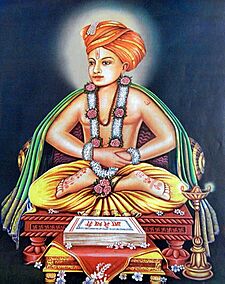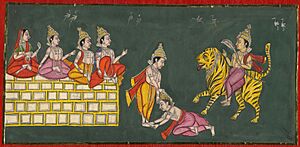Dnyaneshwar facts for kids
Quick facts for kids Dnyaneshwar Vitthalapant Kulkarni |
|
|---|---|
 |
|
| Birth Date | 1275 Apegaon, Yadava dynasty (present-day Paithan Taluka, Chatrapati Sambhaji Nagar, Maharashtra, India) |
| Died on | 1296 (aged 20–21) |
| Birth name | Dnyaneshwar |
| Guru/teacher | Nivruttinath (elder brother) |
| Philosophy | Advaita, Varkari |
| Titles/honors | Sant (Saint), Dev (God) and Māulī |
Sant Dnyaneshwar (1275–1296) was an important Indian saint, poet, and philosopher. He lived in the 13th century in Maharashtra, India. He was a yogi (someone who practices yoga) and belonged to the Nath and Varkari traditions.
Even though he lived only 21 years, he wrote two very famous books. These are the Dnyaneshwari and Amrutanubhav. The Dnyaneshwari is a special explanation of the Bhagavad Gita. These books are the oldest surviving writings in the Marathi language. They are considered very important in Marathi literature.
Sant Dnyaneshwar's ideas were based on the Advaita Vedanta philosophy. This philosophy teaches that everything is one, without separate parts. He also believed strongly in Yoga and bhakti (devotion) to Vithoba. Vithoba is a form of Lord Vishnu. Dnyaneshwar's teachings inspired many other saint-poets like Eknath and Tukaram. He helped start the Varkari Bhakti movement in Maharashtra.
In 1296, Dnyaneshwar entered a deep meditative state called samadhi in Alandi. He chose to leave his body in an underground chamber.
Contents
Who Was Dnyaneshwar?
Dnyaneshwar was born in 1275 in a Marathi-speaking family. This was in Apegaon village, near the Godavari River in Maharashtra. At that time, the Yadava king Ramadevarava ruled the area. The kingdom was peaceful, and the king supported literature and arts.
Most of what we know about Dnyaneshwar comes from the writings of his followers. There are some different stories about his life. But everyone agrees that he finished his famous book, Dnyaneshwari, in 1290 CE. The most accepted dates for his life are 1275 CE for his birth and 1296 CE for his samadhi.
His Early Life
Dnyaneshwar's life story is short, about 21 years. Some parts of it are like legends, with stories of miracles. For example, people say he made a buffalo sing holy verses. Another story says he rode a moving wall to show his spiritual power.
His father, Vitthalapant, was a village accountant in Apegaon. He was a very spiritual person. He married Rakhumabai, and they had no children for a long time. Vitthalapant wanted to learn more about spirituality. So, he decided to become a sannyasin (a renunciate, someone who gives up worldly life). He went to Kashi (Varanasi).
Later, Vitthalapant's spiritual teacher told him to go back to his wife. So, he returned to Alandi and lived as a householder again. Vitthalapant and Rakhumabai then had four children: Nivruttinath (born 1273 CE), Dnyaneshwar (1275 CE), Sopan (1277 CE), and Muktabai (1279 CE).
At that time, it was unusual for a renunciate to return to family life. Because of this, Dnyaneshwar and his siblings faced difficulties. They were not allowed to have the sacred thread ceremony. This ceremony was important for full acceptance into their community.
To escape these problems, Vitthalapant moved his family to Nashik. One day, his eldest son, Nivruttinath, got separated from the family. He met a spiritual teacher named Gahaninath in a cave. Gahaninath taught Nivruttinath the wisdom of the Nath yogis.
Later, Vitthalapant and his wife decided to give up their lives. They hoped this sacrifice would help their children live without persecution. Dnyaneshwar and his siblings were then accepted into the Nath Hindu tradition. All four siblings became celebrated yogis and poets.
His Travels and Samadhi
After writing his book Amrutanubhav, Dnyaneshwar and his siblings visited Pandharpur. There, they met Namdev, who became a close friend. Dnyaneshwar and Namdev traveled to many holy places across India. They helped many people join the Varkari tradition. Dnyaneshwar's devotional poems, called Abhangas, are believed to have been created during this time.
When they returned to Pandharpur, Dnyaneshwar and Namdev were honored. Many other saints of their time joined a special feast.
Dnyaneshwar then decided to enter sanjeevan samadhi. This is a practice where a yogi voluntarily leaves their body in a deep meditative state. On the 13th day of the dark half of the Kartik month in the Hindu Calendar, Dnyaneshwar entered Sanjeevan Samadhi. He was only twenty-one years old. His samadhi (shrine) is in the Siddhesvara Temple complex in Alandi. Many Varkari followers believe that Dnyaneshwar is still alive in spirit.
Stories of Miracles
Many stories about Dnyaneshwar's life include miracles. One famous story tells how he showed the importance of all life. When he was about 12, Dnyaneshwar and his siblings went to Paithan. They wanted help from the priests there. The priests were not kind to them.
Nearby, a man was hurting an old buffalo. Dnyaneshwar asked the man to stop. The priests made fun of him, saying he cared more about an animal than holy teachings. Dnyaneshwar replied that holy texts teach that all life is sacred. The priests then challenged him, saying if that were true, even animals should understand holy texts. Dnyaneshwar then placed his hand on the buffalo's head. The buffalo began to recite a holy verse in a deep voice! This story shows Dnyaneshwar's belief in the sacredness of all beings.
In another story, a powerful yogi named Changdev challenged Dnyaneshwar. Changdev rode on a tiger using his magical powers. Dnyaneshwar humbly showed his own power by riding on a moving wall. Dnyaneshwar gave Changdev advice in 65 verses, known as the Changdev Pasashti. Changdev was so impressed that he became a student of Dnyaneshwar's sister, Muktabai.
His Important Writings
Dnyaneshwar was the first known philosopher to write in the Marathi language. When he was about 16, in 1290, he wrote Dnyaneshwari. This book is an explanation of the Bhagavad Gita. It became a very important text for the Varkari tradition. His words were written down by his follower, Sacchidananda.
Dnyaneshwari was written using a poetic style called Ovi. This style was often used for women's songs in Maharashtra. Dnyaneshwar made the Ovi style very lively and expressive.
In Dnyaneshwari, he included a special prayer called "Pasaayadana." In this prayer, he asked for good things for everyone and all humanity. He asked for nothing for himself. Saint Dnyaneshwar believed that "The whole world has one soul."
He wrote Dnyaneshwari in Marathi, not in the classical Sanskrit language. This was very important. It meant that common people could understand deep philosophical ideas. Before this, only those who knew Sanskrit (usually higher-caste priests) could understand these ideas. Dnyaneshwar made philosophy simple for everyone.
His choice to write in Marathi was a big step away from the old traditions. It helped spread spiritual knowledge to more people. Many compare Dnyaneshwar's importance to Marathi literature to Dante's importance to Italian literature.
Dnyaneshwar's brother and teacher, Nivruttinath, asked him to write another book. This book was an independent philosophical work. It became known as Amrutanubhava. Scholars have different ideas about which book was written first. But both books show Dnyaneshwar's deep philosophical understanding.
His devotional poems, called Abhangas, were likely created during his travels. These poems are a key part of the Varkari tradition.
His Philosophy and Ideas
Dnyaneshwar's ideas were shaped by the Nath Yogi tradition and the Vitthala sect. The Nath Yogis focused on yoga practices and the oneness of Vishnu and Shiva. Dnyaneshwar's brother, Nivruttinath, taught him these Nath Yogi ideas. Dnyaneshwar then taught his younger siblings, Sopana and Muktabai.

Dnyaneshwar believed that reality is clear and doesn't need proof. He taught that true understanding goes beyond simply knowing things. It's about experiencing the truth directly. He even suggested that holy scriptures are valid because they match what we experience, not just because they are old texts.
His Moral Teachings
Dnyaneshwar's ideas about right and wrong come from his explanation of the Bhagavad Gita. He taught that being humble, kind, and patient are important virtues. He also valued being pure in heart and mind, loving quiet time, and being devoted to one's teacher (Guru) and God. He believed that seeing the world as it truly is, helps spiritual growth.
He wrote that true saints see everyone and everything as part of themselves. This makes them humble and compassionate. Devotion to one's Guru was very important to Dnyaneshwar. He often started chapters of his writings by praising his Guru, Nivruttinath. He said Nivruttinath helped him "cross the ocean of existence."
Dnyaneshwar also taught about Karma Yoga. This is about acting without being selfish or expecting rewards. He believed that doing your duties without ego and offering your actions to God leads to self-realization. He taught that the world is a part of the divine. So, we should do our duties and actions as a form of worship.
He believed that divine order and moral order are the same. They are built into the universe. He encouraged protecting social traditions like marriage and family. However, when it came to the caste system, he was more open-minded. He believed that everyone is equal in spirit, no matter their caste.
His Main Works
- Dnyaneshwari or Bhavarthdipika (1290 CE)
- Amrutanubhava or Anubhavamrita (1292 CE)
- Changdev Pasashti (1294 CE)
- Haripath (a collection of devotional songs)
- Abhangas (devotional poems)
See also


